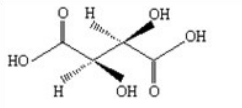Knowde Enhanced TDS
Identification & Functionality
- Ingredient Name
- Food Ingredients Functions
- Molecular formula
- C4H6O6
- Ingredients
- Tartaric Acid
- Food Additive Number
- E 334, INS 334
- Technologies
- Structure

【Isomer】Because it has two mutually symmetrical chiral carbon, it has three isomers, there are L(+)-tartaric acid, D(-)-tartaric acid and meso-tartaric acid. The same amount of L(+)- Tartaric Acid and D(-)-Tartaric Acid mixed will get racemic tartaric acid or DL-Tartaric Acid.
Applications & Uses
- Markets
- Application
- As sour agent, It is widely used in grape wine and some highrade drink production. |
- With its optical activity, L(+)=Tartaric acid is used as chemical resolving agent in pharmaceutical industry.
- As chiral material to synthesize tartrate derivatives.
- As the main raw material of the food emulsifier DATEM, it is widely used in bread, cake, Ice-Cream and other food.
- As retarder, It is widely used in concrete and gypsum.
- With Its complexation, It is used as complexing agent and chelating agent in electroplating, sulfur renoval, acid pickling. .
- It can also complex with multiple metal ion and can be used as cleaning agent or polishing azent of metal surface.
Properties
- Appearance
- Colorless translucent crystal or white powder
- Taste
- Sour
- Typical Properties
| Value | Units | Test Method / Conditions | |
| Molecular Weight | 150.09 | - | - |
| Content | 99.7~100.5 | - | - |
| Specific Rotatory Power ((25°C, D)/[(°C) dn2 kg-1]) | 12~13 | αm | - |
| Arsenic Content | max. 2 | mg/kg | - |
| Lead Content | max. 2 | mg/kg | - |
| Residue On Ignition | max. 0.05 | w/% | - |
| Loss On Drying | max. 0.5 | w/% | - |
| Oxalate | Passes test | - | - |
| Sulfate Content | Passes test | - | - |
Regulatory & Compliance
- Quality index
Our products neet the national standard GB25545-2010 physical1 and chemical indicators, while meeting the United States FCC, USP, UK BP, European EP, Japanese food book and other international standards.
Packaging & Availability
- Packing
25Kg net in Kraft (three layers kraft paper plus PE bag) /Flexible container bag (1lined with PE bags, each bag ontaining 300Kg, 500Kg, 1000Kg etc.). 20NT/20FCL (on pallet).
Storage & Handling
- Storage
Kept away from light, airtight, dry and cool place.

